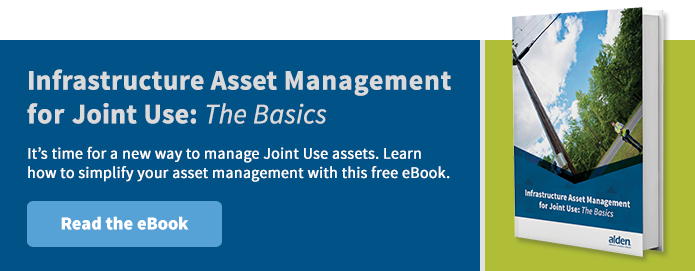Joint Use Violation Most Wanted #5: Mid-Span Vertical Clearance Issues
 While there are many of joint use violation issues, there are a few we see so often we consider them problems of interest: repeat offenses to which no utility pole owner is immune. This blog is the fifth in an ongoing series detailing utility pole issues and the steps it takes to remedy them.
While there are many of joint use violation issues, there are a few we see so often we consider them problems of interest: repeat offenses to which no utility pole owner is immune. This blog is the fifth in an ongoing series detailing utility pole issues and the steps it takes to remedy them.
Today, we discuss something that no one wants to look up from their steering wheel or mid-afternoon run and see themselves heading straight for: low-hanging lines, which amount to mid-span vertical clearance issues.
What is mid-span vertical clearance?
NESC requirements state the following clearance standards for available clear area under a drop cable at mid-span, where the cable’s swag is deepest and it hangs the lowest:
- 15.5 feet over roads, streets, alleys, parking lots, fields and other areas subject to traffic that may be more than 8 feet tall—primarily trucks.
- 11.5 or 15.5 feet over residential driveways, depending on the height of its attachment to a building.
- 23.5 feet over railroad tracks
- 9.5 feet over sidewalks and other pedestrian-only traffic areas.
What can be done?
As with many maintenance-related issues, it is not that pole owners or attaching companies do not have the ability or appetite to fix these problems, often knowing they even exist can prove difficult. Of the hundreds of poles your company owns, how do you know if mid-span issues are occurring in the field, and once identified, how do you track repairs and upkeep?
Robust, online communications platform to handle pole maintenance issues
Using a specialized joint use software platform gives utility pole owners easy access to field inventory data, and provides clear avenues of communication with attachers and internal service crews. Organizing information and fostering transparency helps in identifying and rectifying maintenance issues of all types. This includes potential mid-span issues, as well as tracking repair progress and ensuring problems get fixed. Additionally, users can put timers on common tasks, levy fines against anyone neglecting equipment as stipulated by their contracts, all in service to creating a safe experience on sidewalks and streets everywhere.
Why fix the mid span vertical clearance problems?
Mid-span clearance issues pose a significant danger to the public, and if not remedied, may create costly repairs and costly liability issues should a pedestrian or driver be injured by a low-hanging cable. If left “as-is,” low-hanging aerial plant can snag pedestrians (we will not post the gory details here today), slice through car windshields and catch trains as they speed by. In all instances, if a vehicle were to rip down a low-hanging line, the damage—and cost to the pole owner—could be extensive; certainly more than an ounce of prevention.
